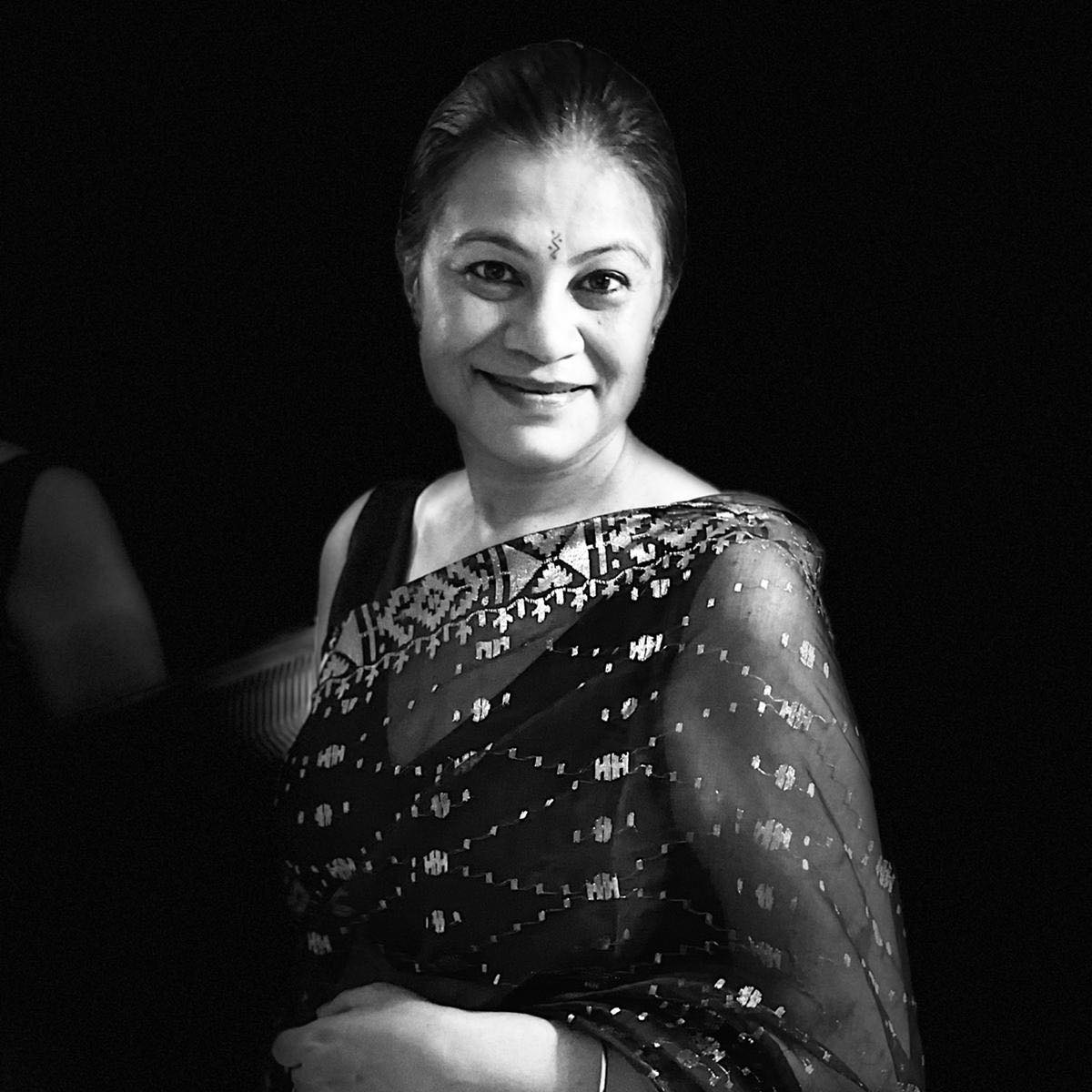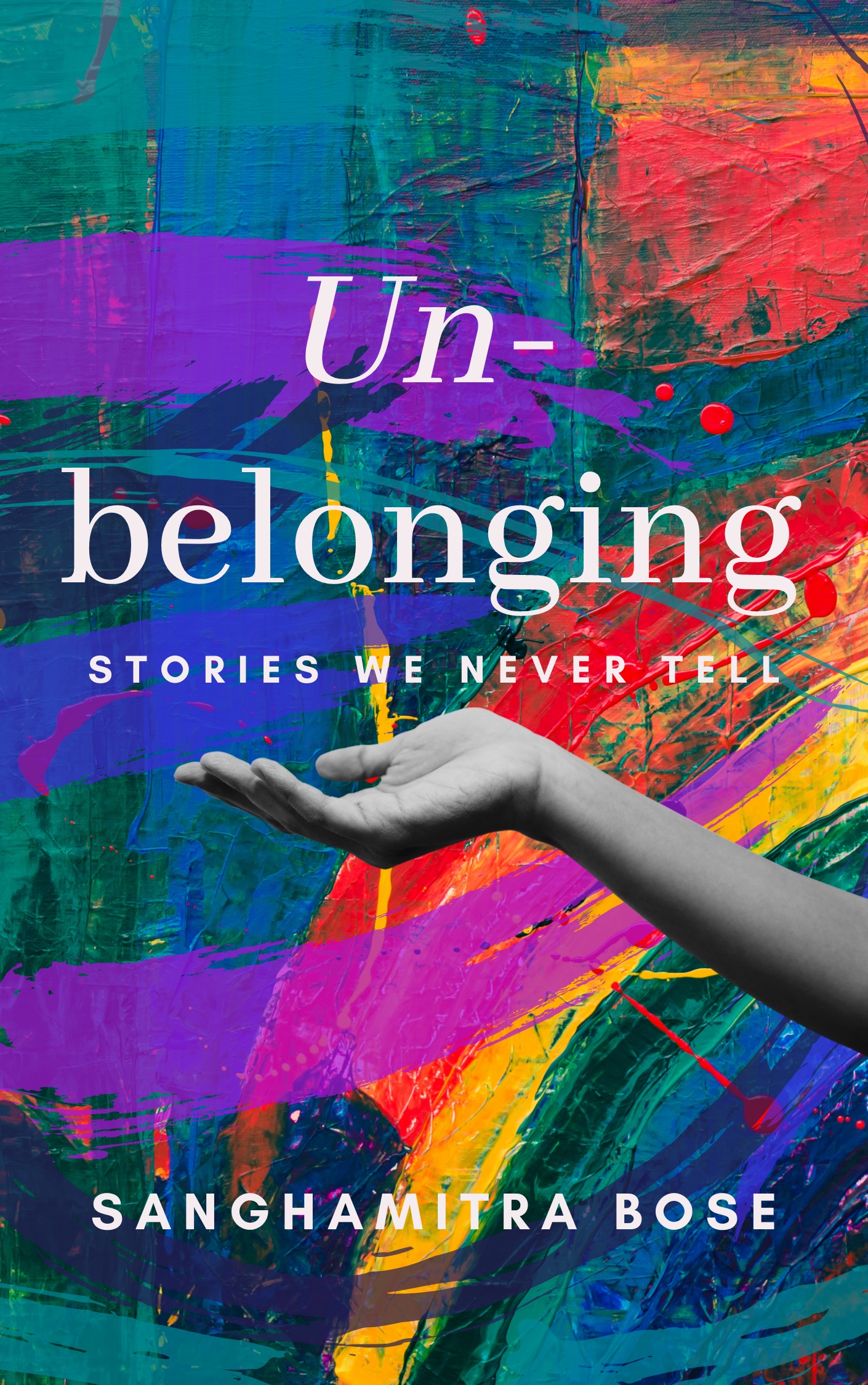
Sanghamitra Bose lives and works in Singapore. An MBA from MS University, Baroda, she has held leadership positions in several industries such as Hospitality, Financial Services, Education and Travel.
Sanghamitra has travelled widely and lived in China, Singapore as well as various cities in India. A lover of history, people and cultures, Sanghamitra gave wings to her passion for writing in 2015. Her first short story was published in the anthology, Tell Me a Story by Penguin India. Since then her stories have been featured in anthologies such as Defiant Dreams: Tales of Everyday Divas and When They Spoke, both published by Readomania.
Her travels in South East Asia have helped her experience different cultures. Her new collection of short stories, Un-belonging, reflects her deep knowledge of South East Asian communities and her nuanced narration skills.
Readomania caught up with this upcoming star on her writing and more.
Readomania: You are a storyteller and you tell stories through various mediums – music, dance, writing, painting. How do you compare these art forms?
Sanghamitra: All art forms are ways of expressing oneself. The choice of art form depends upon the experience that you want your audience to have. Mediums like music, dance, and painting are great in conveying a single powerful message.
Writing on the other hand can convey a multitude of messages at the same time. A single story can have an overarching plot as well as several subplots to help add depth to the narrative. In my book, Un-belonging, a collection of short stories, every story has layers. In the story, Redemption, for example, the domestic worker’s homesickness is overlaid with her employer’s own adjustment issues. Whilst each of the two narratives has its own place when put together, they create a textured tale.
Writing also allows for greater detailing, whether that be in setting a scene or articulating an emotion. Rightly chosen words can conjure up powerful imagery and take the reader to an emotional precipice. Other than theatre and films, writing is the only art form that can create such an experience.
Readomania: What is the foremost task of a storyteller? Entertainment or Societal Reflections? How do you approach your storytelling?
Sanghamitra: A good storyteller is one who not only engages you in the telling but also makes sure that the story stays with you long after. Whilst the main purpose of good fiction is entertainment, the ability to get the reader to reflect on a greater cause, is what takes the story to the next level. For that, the story must touch a universal chord, yet leave the reader with the sense of having learnt something new.
My approach to storytelling is to take an incident or experience and flesh it out in a way that will keep the reader engrossed. This can be done by introducing subplots as well as placing the story in a unique context. Next, I think of what I want the reader to come away with. It could be an ‘aha’ moment, it could be the recollection of a similar experience in their life, or a re-affirmation of a strong belief that they hold, to name a few.
In my story, The Dragonfly, from the collection, Un-belonging, the protagonist belongs to the Peranakan community of South East Asia. Peranakans have a mixed heritage and a unique culture, that forms the fabric of this story. There are also emotions and experiences in the story, that would resonate with anyone who has an ageing parent. So, the reader may identify with the protagonist because of a similar personal experience, or at the very least, come away with an introduction to the Peranakan culture.
My objective in storytelling is to convey an emotionally powerful narrative set in a context that is new for the reader.
Readomania: Why do you write? What inspires you to write?
Sanghamitra: I love the play of words. Having been a voracious reader since childhood, the magic of words on paper has long fascinated me. Over the years, life experiences- my own and that of others, prompted a need to express that narrative. And what better way than with words?
Writing is a form of expression and also a form of catharsis for me. When I hear /read about an incident, or experience a situation that touches me deeply, I write about it. My story Aftermath, from the collection Un-belonging, is based on the Nirbhaya incident in India, and those after. Like many others, I too was shaken by the brutality of the crime. And it led me to think about what would have happened, had Nirbhaya lived. That thought became the basis of my story.
Readomania: Where do you get your story ideas from?
Sanghamitra: My ideas come from incidents and experiences that I or people around me may have encountered. A small incident can grow into a great story. More specifically, not the incident itself, but the emotions underlying that experience. To me, the emotional quotient is key to a good story.
My story, Identity in the collection Un-belonging is based on the Japanese occupation of Singapore during WW2. As the war ended and the Japanese started leaving Singapore, some children born of the union of Japanese soldiers and local women were abandoned and subsequently adopted. It led me to wonder if these children had ever wanted to discover their roots. That became the premise of my story.
 Readomania: ‘Unbelonging’ is based on South East Asian people. How did this idea come to you?
Readomania: ‘Unbelonging’ is based on South East Asian people. How did this idea come to you?
Sanghamitra: I have lived in Singapore for many years now and have travelled extensively in South East Asia. The diversity of culture and heritage in this region has always fascinated me. This region has been an important trade centre, strategically located between China and India, rich in spices and natural resources. There are records way back in 200BC of trade between South India and the Indonesian islands of Java and Sumatra. Over the centuries, many traders, colonizers, and immigrants arrived in South East Asia and settled into the local community. Their intermarriage gave rise to several sub-communities many of which exist till date. The interesting thing about the region’s diversity is also its inclusiveness. It is a harmonious region by and large, at peace with the different parts that make up its whole.
However even in the most inclusive cultures, there exist people that are self- marginalised because of their own experience. The experience can be a result of their sense of identity or lack thereof. They don’t talk about their experience because they are either ashamed or believe that no one wants to hear them. My stories in the collection, Un-belonging, are such narratives. I have based it in South East Asia because of my familiarity with the region and as a mark of respect for the communities that live here.
I hope that the book allows the reader to experience the wonderful diversity of South East Asia through my stories.
Readomania: Are these real stories? How and when were they written?
Sanghamitra: These stories are pure fiction. However, like all good fiction, each has a tiny bit of a true-life narrative. The stories have been written over the past 6 years. I wrote each one at a time when telling that narrative seemed essential to me. You will notice that as you read the stories.
The story, Aftermath, for e.g. was written 7 years ago when the Nirbhaya incident and other similar ones took place in a frightening succession in India. My friends in Singapore were shocked at the brutality of the incidents and I recall women friends unwilling to travel to India at the time. It prompted me to think of what happens after such a life-changing incident, not just for the victim but for others around her. Reviewing it for the collection recently, I was struck by how relevant that narrative still is.
The Dragonfly on the other hand was written last year, during the pandemic. As borders closed, it became impossible to travel and meet family members. This led to the stress of not being able to support loved ones during this crisis. Those feelings of longing, guilt, and helplessness are the basis of The Dragonfly.
Readomania: What works better for you - fiction based on truth or fiction that mirrors truth?
Sanghamitra: Fiction that mirrors truth has authenticity and yet allows for creative licence; so that is my preference. A true-life situation, when taken out of its original context and woven into a new one, gives rise to an entirely different frame of reference. And therein lies a good story.
Redemption, my story in Un-belonging, for e.g. is inspired by my domestic helper who belongs to West Java in Indonesia. Her village is adjacent to a black sand beach. The black sand is formed by erosion of volcanic material and lava over eons. She brought back a boxful of black sand from one of her trips home. The sand sparkles owing to the manganese compounds in it and leaves sparkly bits on one’s hand when one touches it. I was intrigued by the sand and decided to use it as a centrepiece in Redemption. It is a symbol of home and longing, but also a metaphor for the darkness within the two women in this narrative.
Readomania: Do you have a specific way of writing books? What is your method in writing?
Sanghamitra: I am not a structured writer. I have a broad outline before I start writing and the plot grows as I write. In fact, most of my good writing has started with a line or phrase that I felt compelled to pen down. The story, context, and characters were built off that single line. I develop the plot as I go along.
I am also a visual person and write my stories in a way so that the reader can visualize the setting.
I do a lot of stop checks whilst writing. The intent is to keep the narrative tight and entertaining. I rely on my experience of business presentations at work, and constantly review my writing to ensure that it delivers the message. Asking the “so what” question i.e. why this description or element is important to the story, helps me direct the narrative towards the right direction
Sometimes the plot is a simple one, but the narrative makes it into a good story.
Readomania: Are there specific types of characters that appeal to you? Do you base them on people you in reality or are they completely fictional?
Sanghamitra: I am drawn to women characters. Being one, I suppose I understand and express women characters better. They can be from any walk of life, but characters that are complex and layered, appeal most to me.
My characters are developed by combining the characteristics of several real-life people. Hence none of my characters completely resemble a real-life person that I know. However, I try to keep them relevant and as true to real life as possible. This is important for the character to resonate with the reader. The names of my characters are also chosen carefully to reflect their cultural context.
Su Lin from Aftermath, and her friend Gwen are characters that many of us working in Singapore would identify with, yet both are fictional.
Readomania: What has been your favourite story that you have written so far?
Sanghamitra: My story, The Victim, published in Un-belonging is one of my favourite stories. The concept is innovative, I believe. Whilst it explores a common theme of child abuse, the story builds up to a gripping finale and hopefully leaves the reader open-mouthed by the end of it. I had fun conceptualising and writing the story. I hope that readers love it as much as I do.
Readomania: Are there any writing quirks that you follow?
Sanghamitra: I write a lot in the first person because it allows me to express the protagonist’s emotions and thoughts better.
My narrative usually goes back and forth between two different time periods. I believe that it mirrors the way our thoughts usually progress, i.e. not in a linear fashion but as a mix of knowledge, old memories, and new experiences. It also adds an element of mystery to the main plot.
I always let my characters speak in their own voice i.e. language and grammar that comes naturally to the character. Many non-native speakers of English think in their mother tongue and their spoken English reflects grammar and sentence constructs from their mother tongue. I try to infuse this in my characters’ speech. I also use local words to add flavour to the narrative.
Readomania: Who are your favourite authors?
Sanghamitra:
So many! I am an avid reader of historical fiction. Amitava Ghosh, William Dalrymple, and my own sister, Sutapa Basu, are on top of my list, for their brand of historical fiction.
Southeast Asian authors like Meira Chand, Catherine Lim, Suchen Christin Lim, and Balli Kaur Jaswal are also my favourites. Their books give me valuable insights into this region and its culture.
I do love thrillers and bow to Daniel Silva for giving us “Gabriel Allon”!
Lastly, Travel writers like Paul Theroux are my go-to whenever I want to be taken on a journey around the world.
Readomania: Thank you Sanghamitra, for this wonderful interview. We look forward to a lot more stories from your pen.
You can read her book on Kindle. Click here.


Comments